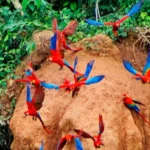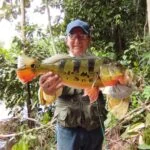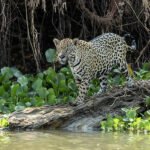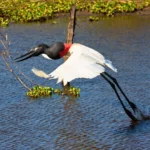
Mammals of the Pantanal: Discover the Wildlife of the Brazilian Wetland

Pantanal, a place where the jaguar, capybaras, and giant anteaters coexist in a vast flooded forest. The Pantanal, the largest freshwater wetland in the world (∼340,000 km²), is home to an incredible wealth of wildlife. This unique ecosystem contains extraordinary biodiversity. Among its many natural wonders are the mammals of the Pantanal, with more than 150 recorded species, in addition to hundreds of birds and thousands of plants. Here it’s easy to see animals that seem straight out of a nature documentary, which explains why so many ecotourists arrive to enjoy wildlife photography safaris in search of unforgettable sightings.

All About the Pantanal
The Pantanal is an alluvial valley that mainly occupies southwest Brazil, and also extends into Bolivia and Paraguay. It is considered the largest wetland in the world. Every year, during the rainy season, up to 80% of the terrain becomes flooded, creating wide rivers and temporary lagoons. When the dry season arrives, water recedes and animals concentrate along the banks, making this the best time to see Brazilian Pantanal wildlife.
In addition to guided tours to see jaguars, the Pantanal offers trails, boat rides, and 4×4 excursions through natural reserves where it is possible to observe and photograph animals in the wild.
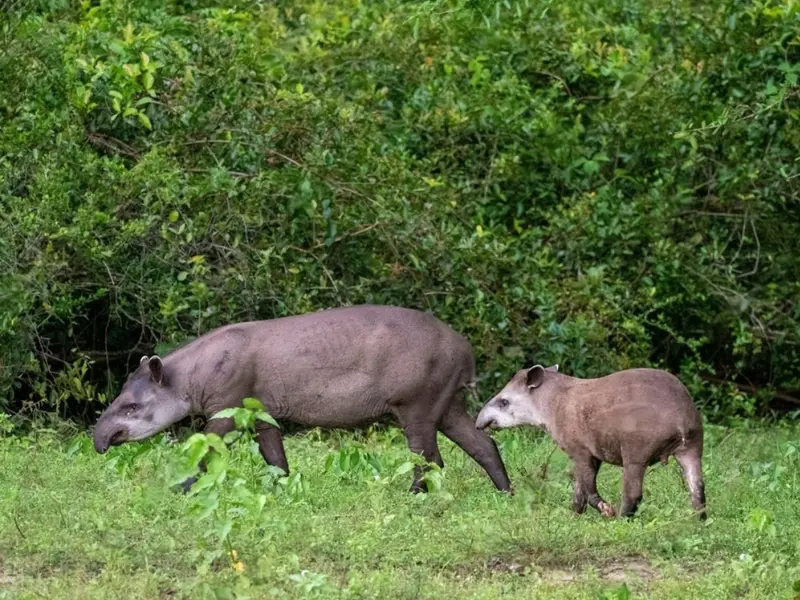
Pantanal and Its Unique Wildlife
The Pantanal stands out for its lush wildlife. More than 160 species of mammals inhabit this wetland, from giants like the jaguar to small rodents and marsupials. There are also numerous reptiles (such as caimans and anacondas) and exotic birds (such as macaws, herons, and toucans).
Its diversity has turned the Pantanal into an ecotourism paradise. Many species living here are iconic, endemic, or protected, which has promoted nature tourism routes and conservation programs in the region.

List of Brazilian Pantanal Mammals
Below, discover the 19 most notable mammals of the Brazilian Pantanal, with their most important characteristics so you know which animals to see in the Pantanal and how to identify them.
1. Jaguar (Panthera onca)
The jaguar is the largest cat in the Americas and the most powerful predator in the Pantanal. Its strength, stealth, and swimming ability make it a dominant hunter in this ecosystem. It is, without a doubt, one of the most emblematic Pantanal mammals and the most sought-after animal on wildlife photography safaris, especially in areas like Porto Jofre. Seeing it in the wild is an unforgettable experience for wildlife lovers.
- Body length: 150 cm
- Weight: 70–110 kg
- Gestation period: 100 days
- Diet: Hunts deer, capybaras, turtles, fish, and more
- Lifespan: 10–12 years

2. Southern Tamandua (Tamandua tetradactyla)
This arboreal anteater searches for ants and termites with its sticky tongue.
- Body length: 80 cm
- Weight: 7 kg
- Gestation period: 130–150 days
- Diet: Insectivore
- Lifespan: 9–12 years
3. Pampas Deer (Ozotoceros bezoarticus)
A savanna deer that inhabits open areas and grasslands of the Pantanal, where it finds abundant food and good visibility to detect predators. It is a light, agile species, adapted to flat, dry terrains. It is among the most representative Pantanal mammals, and although shy, it can be seen during well-organized safaris.
- Body length: 115–140 cm
- Weight: 30–40 kg
- Gestation period: 210 days
- Diet: Herbivore
- Lifespan: Up to 30 years
4. Six-banded Armadillo (Euphractus sexcinctus)
Also known as the yellow armadillo, it possesses a strong shell.
- Body length: 40–50 cm
- Weight: 3–8 kg
- Gestation period: 60–75 days
- Diet: Insects, fruit, carrion
- Lifespan: 15 years
5. Common Opossum (Didelphis marsupialis)
A resilient marsupial that adapts easily to various environments.
- Body length: 32–50 cm
- Weight: 5.5 kg
- Gestation period: 12–14 days
- Diet: Omnivore
- Lifespan: ~2 years
6. Giant Anteater (Myrmecophaga tridactyla)
One of the largest mammals in the Pantanal, easily recognized by its long snout and thick tail. This solitary animal travels across large areas in search of ants and termites, which it consumes with its long sticky tongue. It is one of the most impressive Pantanal mammals, and although calm, its size and appearance attract visitors’ attention.
- Body length: 130 cm
- Weight: 40 kg
- Gestation period: 120–190 days
- Diet: Termites and ants
- Lifespan: 26 years
7. South American Tapir (Tapirus terrestris)
The heaviest terrestrial mammal in the Pantanal.
- Body length: 180–250 cm
- Weight: 150–250 kg
- Gestation period: 385–412 days
- Diet: Leaves, fruits, roots
- Lifespan: 35 years
8. Capybara (Hydrochoerus hydrochaeris)
The largest rodent in the world, very common near lakes, rivers, and flooded areas of the Pantanal. It is a social animal, usually traveling in family groups, especially active at dawn and dusk. Due to its abundance and calm behavior, it is one of the easy-to-spot Pantanal mammals on boat or walking tours.
- Body length: 100–130 cm
- Weight: ~80 kg
- Gestation period: 150 days
- Diet: Grass, aquatic plants
- Lifespan: 10 years
9. Black Howler Monkey (Alouatta caraya)
Known for its loud howls, which can be heard for miles away.
- Body length: 60–90 cm
- Weight: 4–10 kg
- Gestation period: 180–190 days
- Diet: Leaves and fruits
- Lifespan: 20 years
10. Black Capuchin Monkey (Cebus apella)
An intelligent and curious primate, which uses simple tools.
- Body length: 30–58 cm
- Weight: 2–4 kg
- Gestation period: 150–180 days
- Diet: Fruits, insects, eggs
- Lifespan: 15–25 years
11. Azara’s Agouti (Dasyprocta azarae)
A ground-dwelling rodent that disperses seeds and lives in burrows.
- Body length: 40–64 cm
- Weight: 250 g
- Gestation period: 100–120 days
- Diet: Fruit, roots, seeds
- Lifespan: 15–18 years
12. Greater Grison (Galictis vittata)
A small agile carnivore, closely related to the otter. It’s one of the most interesting Pantanal mammals due to its active behavior and varied diet. It can be found in wooded areas and near waterways.
- Body length: 48–80 cm
- Weight: 0.8–2.0 kg
- Gestation period: 40 days
- Diet: Small animals, nuts
- Lifespan: 6–8 years
13. South American Coati (Nasua nasua)
A social and omnivorous animal, very active both on the ground and in the trees.
- Body length: 43 - 66 cm
- Weight: 3.5 - 6 kg
- Gestation period: 75 days
- Diet: Insects, fruits, meat
- Lifespan: 14 years
14. Crab-eating Fox (Cerdocyon thous)
A nocturnal canid that also eats crabs and fruits.
- Body length: ~64 cm
- Weight: 6 - 8 kg
- Gestation period: 55 - 58 days
- Diet: Omnivore
- Lifespan: 11 years
15. Maned Wolf (Chrysocyon brachyurus)
A tall, long-legged canid with a diet of fruits and meat. It is a solitary and elusive species, but considered one of the most unique and charismatic mammals of the Pantanal. It is currently threatened by habitat loss, which has triggered various conservation efforts.
- Body length: 90 cm
- Weight: 20 - 25 kg
- Gestation period: 65 days
- Diet: Fruits, rodents, birds
- Lifespan: 10 - 12 years
16. Emilia’s Marmoset (Mico emiliae)
A small, diurnal monkey, common in riverside areas.
- Body length: 20 - 30 cm
- Weight: 300 - 400 g
- Gestation period: 130 - 150 days
- Diet: Fruits, insects
- Lifespan: 15 - 18 years
17. White-lipped Peccary (Tayassu pecari)
A wild relative of the pig, lives in large groups.
- Body length: 91 - 130 cm
- Weight: 25 - 40 kg
- Gestation period: 156 - 162 days
- Diet: Fruits, roots, insects
- Lifespan: 15 years
18. Giant Otter (Pteronura brasiliensis)
Also called ariranha, it is the largest otter in the Americas.
- Body length: 210 cm
- Weight: 32 kg
- Gestation period: 70 days
- Diet: Fish, crabs, reptiles
- Lifespan: 10 years
19. Neotropical Otter (Lontra longicaudis)
A smaller, solitary otter with discreet habits that inhabits rivers, streams, and lagoons in the Pantanal. It is an expert aquatic hunter, capable of catching fish and crustaceans with great agility underwater. Although less visible than its giant relative, it is still part of the Pantanal’s mammal population and plays an important role in the ecological balance of aquatic ecosystems.
- Body length: 55 - 120 cm
- Weight: Up to 35 kg
- Gestation period: 60 - 80 days
- Diet: Fish, crustaceans, reptiles
- Lifespan: 10 - 12 years
Frequently Asked Questions About Pantanal Mammals

1. What are the most well-known mammals of the Pantanal?
The most sought-after by visitors are the jaguar, capybara, giant anteater, South American tapir, and the howler monkey.
2. Where can you see jaguars in the Pantanal?
The best spots are Porto Jofre and the Encontro das Águas State Park, known for their high jaguar density. Guided boat tours and land safaris are organized here to observe them in the wild.
3. What is the best time to see wildlife in the Pantanal?
The dry season, from June to October, is ideal for wildlife viewing, as animals gather near rivers and lagoons.
4. Which Pantanal species are endangered?
The maned wolf, giant otter, white-lipped peccary, and some otter species are threatened. That’s why protecting the Pantanal’s natural habitat is crucial.
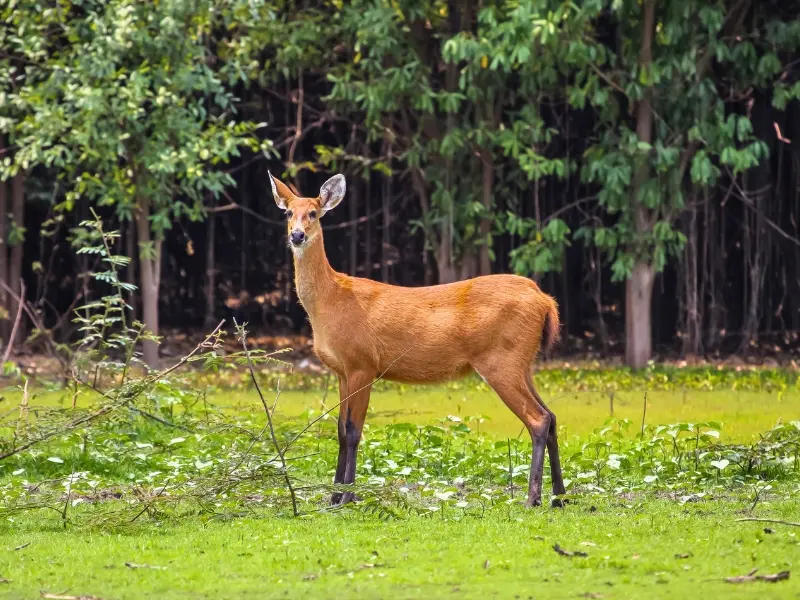
The mammals of the Brazilian Pantanal include impressive species such as the jaguar, capybara, South American tapir, and the giant otter. This vast wetland is home to more than 150 species of wild mammals. Exploring the Pantanal is a unique opportunity to see wildlife in its natural habitat through thrilling safaris and guided tours. Book today and discover the mammals that inhabit the Pantanal on an exciting tour.
Pantanal Mammal Watching Tours
Random Posts

Weather in Tambopata on February

 English
English  Español
Español  Português
Português 
 English
English 























